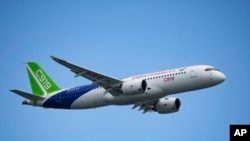China’s C919 single-aisle jet made its international debut at the Singapore Airshow, attracting masses of visitors and hundreds of orders, but analysts say it still has a long way to go before it can compete with aircraft from market leaders Boeing and Airbus.
The Commercial Aircraft Corporation of China (COMAC) has received over 1,000 orders for the jet, mostly from Chinese airlines. A lack of international certification means the aircraft cannot operate commercially in most countries unless they recognize certifications by China’s civil aviation regulator.
During last week's airshow, which drew nearly 120,000 trade and public visitors, the C919 performed flybys, letting visitors see the jet in action. Its only previous foray outside mainland China was to Hong Kong in December.
“It’s quite symbolic and a major milestone in that push by China to become considered, alongside Airbus and Boeing, for commercial aircraft,” said Brendan Sobie, an independent aviation analyst based in Singapore.
Another aspect COMAC needs to work on before its jets can become serious contenders alongside the Airbus A320neo and Boeing’s 737 Max narrow-body airliners is building up a reliable distribution system and market support services for its aircraft.
“The challenge moving forward is that in order to have a sustainable future, COMAC must demonstrate that they are able to go beyond Chinese shores,” said Mabel Kwan, managing director at consultancy Alton Aviation.
COMAC declined to make its executives available for an interview.
So far, the state-owned company says it has received 1,061 domestic orders for the C919, but it has yet to secure many international customers. Brunei-based GallopAir, which is backed by Chinese investors, signed a letter of intent in September to purchase 30 aircraft from COMAC, including a C919 jet, in a deal estimated to be worth $2 billion.
COMAC faces supply chain challenges like those of Boeing and Airbus, which have backlogs of thousands of aircraft yet to be delivered. While the C919 is designed in China, much of its technology and many of its parts are from foreign suppliers. Its engine, for example, is made by CFM International, a joint venture between GE Aerospace and France’s Safran Aircraft Engines.
“It’s not like China has its own supply system, its own avionics, its own engines, so that they’re not impacted by what’s happening globally,” Sobie said, adding that COMAC might not be a high priority for suppliers also struggling to catch up with deliveries to Boeing and Airbus.
COMAC, however, does have the luxury of a wide talent pool from China, Kwan said, and in the long run this may allow the firm to develop more homegrown technology and parts for use in its aircraft.
“Right now, COMAC is using mostly Western technology … but with enough research and development, training and education, the whole ecosystem may be able to overcome [challenges in the long term],” she said.





